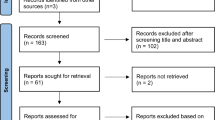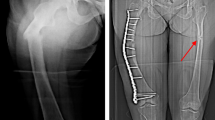Abstract
Summary
In this study, we report on clinical, radiographic and biochemical characteristics of 38 patients with adult hypophosphatasia. High-resolution peripheral quantitative computed tomography showed alterations of bone microstructure in a subgroup of 14 patients. Pyridoxal-5-phosphate levels correlated with the occurrence of fractures and the number of symptoms.
Introduction
Hypophosphatasia (HPP) is a rare disorder with a wide range of clinical manifestations. A reduced enzymatic activity of alkaline phosphatase (ALP) is the key marker of the disease, causing an accumulation of ALP substrates such as pyridoxal-5-phosphate (PLP). The purpose of this retrospective study was to further characterize adult onset HPP.
Methods
We assessed clinical, radiographic and laboratory characteristics of 38 adult patients with HPP. Diagnosis of HPP was established by the combination of low-serum ALP, raised PLP levels and typical symptoms and was genetically confirmed in 32 patients. Dual-energy X-ray absorptiometry (DXA) and laboratory data were available in most patients. High-resolution peripheral quantitative computed tomography (HR-pQCT) was performed in 14 patients.
Results
Clinical characteristics included a wide spectrum of symptoms. A history of fracture was present in 15 patients (39%). Twenty-one patients (55%) complained about recurring headaches, 23 patients (61%) had recurring muscle pain, 4 patients (11%) suffered from severe muscle weakness and 18 patients (47%) showed dental abnormalities. Z-scores assessed by DXA were only slightly reduced in most adult HPP patients. HR-pQCT of 14 patients showed microstructural changes of trabecular and cortical bone compared to reference values of healthy subjects. The occurrence of fractures and multiple symptoms (>2 typical HPP symptoms) were associated with significantly elevated levels of PLP.
Conclusion
Adult HPP presents with a wide range of clinical symptoms and is not associated with low bone mass in general. PLP seems to be a good marker for disease severity in adult patients as its level is correlated with the occurrence of fractures and number of symptoms.



Similar content being viewed by others
References
Weiss MJ, Cole DE, Ray K, Whyte MP, Lafferty MA, Mulivor RA, Harris H (1988) A missense mutation in the human liver/bone/kidney alkaline phosphatase gene causing a lethal form of hypophosphatasia. Proc Natl Acad Sci U S A 85(20):7666–7669
Fraser D (1957) Hypophosphatasia. Am J Med 22(5):730–746
Mornet E (2015) Molecular genetics of hypophosphatasia and phenotype-genotype correlations. Subcell Biochem 76:25–43. doi:10.1007/978-94-017-7197-9_2
Mornet E, Yvard A, Taillandier A, Fauvert D, Simon-Bouy B (2011) A molecular-based estimation of the prevalence of hypophosphatasia in the European population. Ann Hum Genet 75(3):439–445. doi:10.1111/j.1469-1809.2011.00642.x
McKiernan FE, Berg RL, Fuehrer J (2014) Clinical and radiographic findings in adults with persistent hypophosphatasemia. J Bone Miner Res 29(7):1651–1660. doi:10.1002/jbmr.2178
Silvent J, Gasse B, Mornet E, Sire JY (2014) Molecular evolution of the tissue-nonspecific alkaline phosphatase allows prediction and validation of missense mutations responsible for hypophosphatasia. J Biol Chem 289(35):24168–24179. doi:10.1074/jbc.M114.576843
Bianchi ML (2015) Hypophosphatasia: an overview of the disease and its treatment. Osteoporos Int 26(12):2743–2757. doi:10.1007/s00198-015-3272-1
Cole DE (2008) Hypophosphatasia update: recent advances in diagnosis and treatment. Clin Genet 73(3):232–235. doi:10.1111/j.1399-0004.2007.00958.x
Whyte MP (1990) Heritable metabolic and dysplastic bone diseases. Endocrinol Metab Clin N Am 19(1):133–173
Berkseth KE, Tebben PJ, Drake MT, Hefferan TE, Jewison DE, Wermers RA (2013) Clinical spectrum of hypophosphatasia diagnosed in adults. Bone 54(1):21–27. doi:10.1016/j.bone.2013.01.024
Riancho-Zarrabeitia L, Garcia-Unzueta M, Tenorio JA, Gomez-Gerique JA, Ruiz Perez VL, Heath KE, Lapunzina P, Riancho JA (2016) Clinical, biochemical and genetic spectrum of low alkaline phosphatase levels in adults. Eur J Intern Med 29:40–45. doi:10.1016/j.ejim.2015.12.019
Whyte MP (2010) Physiological role of alkaline phosphatase explored in hypophosphatasia. Ann N Y Acad Sci 1192:190–200. doi:10.1111/j.1749-6632.2010.05387.x
Whyte MP, Walkenhorst DA, Fedde KN, Henthorn PS, Hill CS (1996) Hypophosphatasia: levels of bone alkaline phosphatase immunoreactivity in serum reflect disease severity. J Clin Endocrinol Metab 81(6):2142–2148. doi:10.1210/jcem.81.6.8964842
Whyte MP (2012) Hypophosphatasia. In: Glorieux FH, Pettifor JM, Juppner H (eds) Pediatric bone biology & diseases, 2nd edn. Elsevier, Amsterdam, pp 771–794
Hofmann C, Girschick HJ, Mentrup B, Graser S, Seefried L, Liese J, Jakob F (2013) Clinical aspects of hypophosphatasia: an update. Clinical Reviews in Bone and Mineral Metabolism 11(2):60–70. doi:10.1007/s12018-013-9139-0
Beck C, Morbach H, Wirth C, Beer M, Girschick HJ (2011) Whole-body MRI in the childhood form of hypophosphatasia. Rheumatol Int 31(10):1315–1320. doi:10.1007/s00296-010-1493-3
Whyte MP, Zhang F, Wenkert D, McAlister WH, Mack KE, Benigno MC, Coburn SP, Wagy S, Griffin DM, Ericson KL, Mumm S (2015) Hypophosphatasia: validation and expansion of the clinical nosology for children from 25 years experience with 173 pediatric patients. Bone 75:229–239. doi:10.1016/j.bone.2015.02.022
Barvencik F, Beil FT, Gebauer M, Busse B, Koehne T, Seitz S, Zustin J, Pogoda P, Schinke T, Amling M (2011) Skeletal mineralization defects in adult hypophosphatasia—a clinical and histological analysis. Osteoporos Int 22(10):2667–2675. doi:10.1007/s00198-011-1528-y
Wuster C, Ziegler R (1992) Reduced bone mineral density and low parathyroid hormone levels in patients with the adult form of hypophosphatasia. Clin Investig 70(7):560–565
Girschick HJ, Haubitz I, Hiort O, Schneider P (2007) Long-term follow-up of bone mineral density in childhood hypophosphatasia. Joint Bone Spine 74(3):263–269. doi:10.1016/j.jbspin.2006.06.017
Thomas L, Müller M, Schumann G, Weidemann G, Klein G et al (2005) Consensus of DGKL and VDGH for interim reference intervals on enzymes in serum. J Lab Med 29:301–308
Sampson DA, O'Connor DK Analysis of B-6 vitamers and pyridoxic acid in plasma, tissues and urine using high performance liquid chromatography. Nutr Res 9(3):259–272. doi:10.1016/S0271-5317(89)80069-7
Burt LA, Liang Z, Sajobi TT, Hanley DA, Boyd SK (2016) Sex- and site-specific normative data curves for HR-pQCT. J Bone Miner Res 31(11):2041–2047. doi:10.1002/jbmr.2873
Whyte MP, Teitelbaum SL, Murphy WA, Bergfeld MA, Avioli LV (1979) Adult hypophosphatasia. Clinical, laboratory, and genetic investigation of a large kindred with review of the literature. Medicine (Baltimore) 58(5):329–347
Weber TJ, Sawyer EK, Moseley S, Odrljin T, Kishnani PS (2016) Burden of disease in adult patients with hypophosphatasia: results from two patient-reported surveys. Metabolism 65(10):1522–1530. doi:10.1016/j.metabol.2016.07.006
Khandwala HM, Mumm S, Whyte MP (2006) Low serum alkaline phosphatase activity and pathologic fracture: case report and brief review of hypophosphatasia diagnosed in adulthood. Endocr Pract 12(6):676–681. doi:10.4158/EP.12.6.676
Sutton RA, Mumm S, Coburn SP, Ericson KL, Whyte MP (2012) “Atypical femoral fractures” during bisphosphonate exposure in adult hypophosphatasia. J Bone Miner Res 27(5):987–994. doi:10.1002/jbmr.1565
Whyte MP (2016) Hypophosphatasia—aetiology, nosology, pathogenesis, diagnosis and treatment. Nat Rev Endocrinol 12(4):233–246. doi:10.1038/nrendo.2016.14
Otero JE, Gottesman GS, McAlister WH, Mumm S, Madson KL, Kiffer-Moreira T, Sheen C, Millan JL, Ericson KL, Whyte MP (2013) Severe skeletal toxicity from protracted etidronate therapy for generalized arterial calcification of infancy. J Bone Miner Res 28(2):419–430. doi:10.1002/jbmr.1752
Hofmann C, Girschick H, Mornet E, Schneider D, Jakob F, Mentrup B (2014) Unexpected high intrafamilial phenotypic variability observed in hypophosphatasia. Eur J Hum Genet 22(10):1160–1164. doi:10.1038/ejhg.2014.10
Whyte MP (2017) Hypophosphatasia: enzyme replacement therapy brings new opportunities and new challenges. J Bone Miner Res. doi:10.1002/jbmr.3075
Sornay-Rendu E, Boutroy S, Munoz F, Delmas PD (2007) Alterations of cortical and trabecular architecture are associated with fractures in postmenopausal women, partially independent of decreased BMD measured by DXA: the OFELY study. J Bone Miner Res 22(3):425–433. doi:10.1359/jbmr.061206
Vilayphiou N, Boutroy S, Szulc P, van Rietbergen B, Munoz F, Delmas PD, Chapurlat R (2011) Finite element analysis performed on radius and tibia HR-pQCT images and fragility fractures at all sites in men. J Bone Miner Res 26(5):965–973. doi:10.1002/jbmr.297
Nakagawa H, Kamimura M, Takahara K, Hashidate H, Kawaguchi A, Uchiyama S, Miyasaka T (2006) Changes in total alkaline phosphatase level after hip fracture: comparison between femoral neck and trochanter fractures. J Orthop Sci 11(2):135–139. doi:10.1007/s00776-005-0990-9
Phillips D, Case LE, Griffin D, Hamilton K, Lara SL, Leiro B, Monfreda J, Westlake E, Kishnani PS (2016) Physical therapy management of infants and children with hypophosphatasia. Mol Genet Metab 119(1–2):14–19. doi:10.1016/j.ymgme.2016.06.010
Camacho PM, Mazhari AM, Wilczynski C, Kadanoff R, Mumm S, Whyte MP (2016) Adult Hypophosphatasia treated with teriparatide: report of two patients and review of the literature. Endocr Pract. doi:10.4158/EP15890.OR
Whyte MP, Rockman-Greenberg C, Ozono K, Riese R, Moseley S, Melian A, Thompson DD, Bishop N, Hofmann C (2016) Asfotase alfa treatment improves survival for perinatal and infantile hypophosphatasia. J Clin Endocrinol Metab 101(1):334–342. doi:10.1210/jc.2015-3462
Whyte MP, Greenberg CR, Salman NJ, Bober MB, McAlister WH, Wenkert D, Van Sickle BJ, Simmons JH, Edgar TS, Bauer ML, Hamdan MA, Bishop N, Lutz RE, McGinn M, Craig S, Moore JN, Taylor JW, Cleveland RH, Cranley WR, Lim R, Thacher TD, Mayhew JE, Downs M, Millan JL, Skrinar AM, Crine P, Landy H (2012) Enzyme-replacement therapy in life-threatening hypophosphatasia. N Engl J Med 366(10):904–913. doi:10.1056/NEJMoa1106173
Kishnani PS, Rockman-Greenberg C, Whyte MP et al (2012) Hypophosphatasia: enzyme replacement therapy (Asfotase alfa) decreases TNSALP substrate accumulation and improves functional outcome in affected adolescents and adults. American College of Medical Genetics and Genomics Annual Meeting, Charlotte, pp 27–31
Acknowledgments
Authors’ roles: Study design: TS, HM, FB, WR and MA. Study conduct: TS, HM and FB. Data collection: HM, TR, JH and TH. Data analysis: TS. Drafting manuscript: TS, HM and FB. Approving final version of manuscript: TS, HM, TS, TW, JH, WR, MA and FB. TS takes responsibility for the integrity of the data analysis.
Author information
Authors and Affiliations
Corresponding author
Ethics declarations
The local ethics committee approved the study (PV5272).
Conflict of interest
Tobias Schmidt, Haider Mussawy, Tim Rolvien, Thelonius Hawellek, Jan Hubert, Wolfgang Rüther, Michael Amling and Florian Barvencik declare that they have no conflict of interest. F.B. receives speaker and consultant fees from Alexion, Lilly, and MSD. M.A. receives speaker and consultant fees from Merck.
Electronic supplementary material
Supplemental Table 1
(DOCX 27 kb)
Supplemental Table 2
(DOCX 15 kb)
Supplemental Figure 1
a) Z-scores and T-scores of left femoral neck of patients with a history of fracture are compared to patients without fractures; b) Z-scores and T-scores of lumbar spine of patients with a history of fracture are compared to patients without fractures (GIF 23 kb)
Supplemental Figure 2
Ten patients received low-dose vitamin D substitution (500 I.E.–1000 I.E.) and were regularly monitored for serum levels of 25-OH-D, calcium and phosphate. Mean values of absolute changes in serum levels ±SD (GIF 17 kb)
Rights and permissions
About this article
Cite this article
Schmidt, T., Mussawy, H., Rolvien, T. et al. Clinical, radiographic and biochemical characteristics of adult hypophosphatasia. Osteoporos Int 28, 2653–2662 (2017). https://doi.org/10.1007/s00198-017-4087-z
Received:
Accepted:
Published:
Issue Date:
DOI: https://doi.org/10.1007/s00198-017-4087-z




